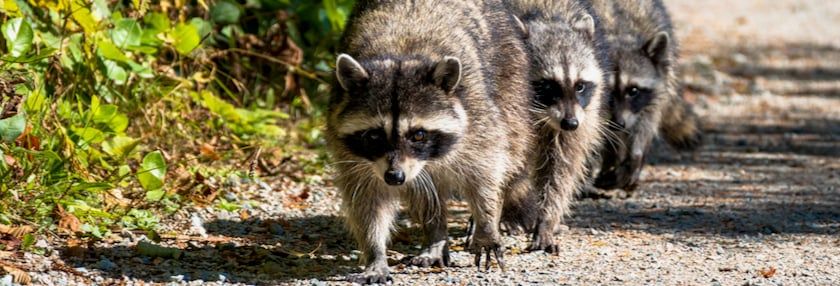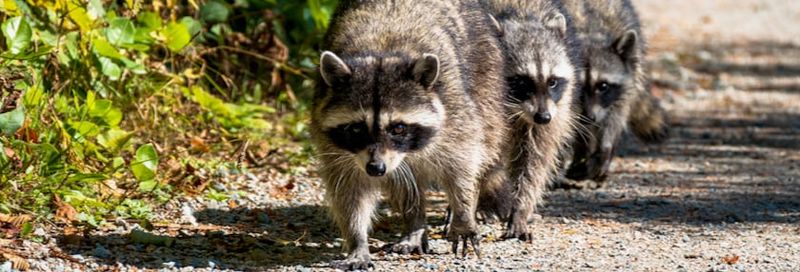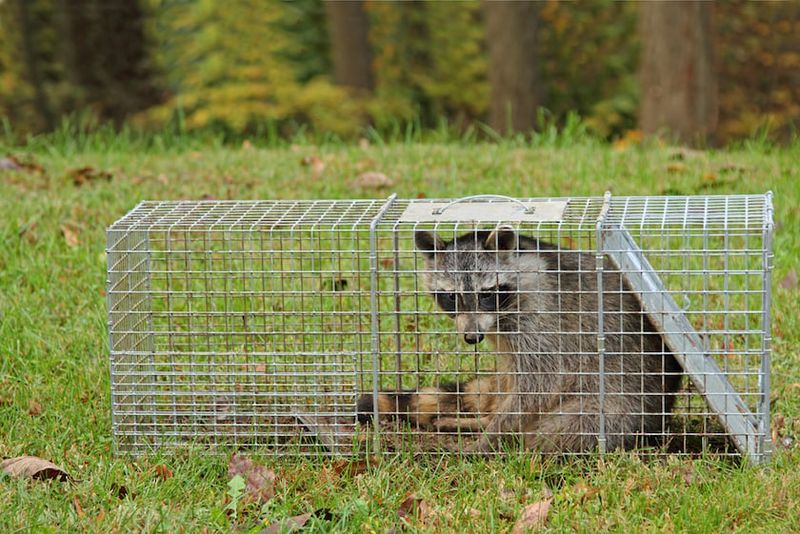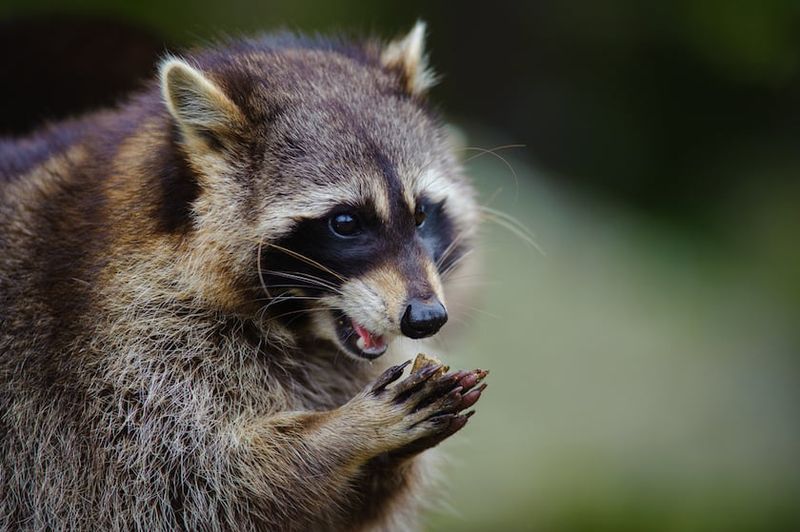Masked Bandits


Raccoons may look adorable, but damage is their calling card
The sweet corn may have grown well all summer, but that makes the sense of frustration even worse when the rising sun illuminates your loss. Cornstalks are broken down indiscriminately and ears are stripped and chewed down to the cob.

In the soft dirt, unmistakable hand-like prints are everywhere. The masked bandits have struck.
Even so, it’s hard not to marvel at the raccoon’s industrious actions. Highly intelligent and adaptable animals, raccoons are found across the United States. They are equally at home in the cold and wind of the Great Plain or the humid South.
At the northern edge of their range, they can weigh up to 40 pounds, with the largest recorded tipping the scales at an unbelievable 60 pounds! Mature specimens in southern Florida may weigh less than 10 pounds.
Unfortunately, these nocturnal omnivores have a taste for just about anything a homestead produces.
What have you got to eat?
Raccoons go through a torpor period in colder climates, spending most of the cold winter sleeping in den trees. Drawing energy from fat reserves, by spring the animals have lost nearly 40% of their bodyweight. Putting back on weight is a major consideration come spring, and eggs are one of the best ways to accomplish that.
Nests created by ground-nesting birds are most often raided. Turkeys, pheasants, and quail are just a few of the birds that lose eggs each spring to raccoons.
Raccoons seem to have a special affinity for chicken eggs.
Fortunately, keeping them away from hens is not overly difficult. Raccoons don’t generally dig into enclosures like other animals, so keeping hens and eggs are as easy as keeping them in an enclosure, especially at night. Keeping food and water inside a coop, where the raccoon is less likely to smell them, will help deter the bandits.

Garden crops are another story. Raccoons love sweet corn, melons, tree fruits, strawberries and peas, among others.
They’re uniquely adapted as raiders
By studying the feet of a raccoon, it’s easy to realize why they can be so destructive. They have human-like front paws that are hyper-sensitive to touch and become even more so when wet. In fact, scientists believe almost two-thirds of the raccoon’s cerebral cortex’s sensory perception area is made for tactile impulses.
This is greater than any other animal that has been studied in that manner. These special, hyper-sensitive paws allow the raccoon to grasp and manipulate food, garbage covers and many other objects in ways no other animal can.
The diet of the raccoon also makes them the bane of the homesteader.
Nearly equally split in thirds, raccoons eat invertebrates, vegetation, and vertebrates. The poster animal for omnivores, the raccoon shifts its diet during the year, starting with the above-mentioned eggs as well as insects and worms. They then transition to fruits, nuts, and vegetables in the late summer and fall, gorging high-calorie foods for winter.
At this point is the intersection with the homesteader.
Keeping bandits away
Most defenses that work to protect a garden or crop against deer or other animals do not work on a raccoon. Electric fences pose little threat to them, as their heavy coat protects them as they crawl under a fence. Their climbing ability also makes it easy for them to go up a wooden post and over the fence. Noxious sprays, like Plantskyyd or liquid fence, may actually attract raccoons, some say.
So, what is the best defense?
Dogs can do a great job of protecting a garden or livestock. An aggressive dog, barking and chasing a raccoon, will soon cause the marauder to seek quieter pastures.
However, there are a few major drawbacks to using dogs. Especially around older homes or those with outbuildings, the dog may cause the raccoons to take up residence in areas that are safe from the dogs but close to the garden.
Homesteaders are commonly told to reduce conflict from raccoons by making the property less attractive. For instance, cat or dog food shouldn’t be left around at night, and lids should be tightly affixed to garbage cans.
Otherwise, it would take quite a bit of work to make a rural property less attractive. Trees provide denning locations, and outbuildings—no matter how clean—provide shelter.
You can always trap the critter
The most efficient way to control raccoons, both in time and money, is trapping. Before trying to trap, a landowner should make sure raccoons are the culprit.
Try installing a trail camera or two. Many models are inexpensive, and they will provide clear evidence of the critter causing a problem. (It’s also great fun to see what night-time trespassers you have.)
Cage-style live traps work well, providing they are stout enough to handle the animal.

A 15-pound raccoon may look soft and cuddly, but they are pound-for-pound one of the strongest animals on the planet.
Once caught, many homesteaders re-locate the animals somewhere else. That animal will either find its way back, or cause problems for someone else unless moved far away into the wilderness.
View as a ‘wild asset’ to enjoy
Try looking at a raccoon as more than a homestead pest. If they need to be removed from the landscape, there is a lot to be utilized on the animal.
Fur—Downturns in the fur market have diminished the commercial value of the pelt, however for a homesteader that doesn’t matter, as the fur can be utilized at home.
After removing the hide and the associated fat and meat, the pelt then can be salted to remove moisture. There are numerous reputable tanneries around the country that will turn the pelt into a beautiful piece of leather, or it can be done at home with a kit from a taxidermy supply company.
A tanned pelt can be used for a variety of uses. Fur can be made into warm hats and mittens, among other garments—even a howling North Dakota blizzard is no match for a pair of raccoon fur mittens and a bomber hat.
Meat—Raccoons are a great source of meat, but if the animal appears sick, do not consume it. Raccoons can carry roundworms and leptospirosis, both found in fecal matter.
When skinning the animal, rubber gloves protect from transmission of disease. Use a skinning knife to remove the hide, then switch to a different knife to harvest the meat.
Keeping the meat clean and untainted is paramount.
No matter if it’s a young or old animal, they are tough. Pressure cooking tenderizes the front and rear quarters, and cooks it thoroughly. After removing the fat, the resulting meat is rich and tender. Many love it drenched in barbeque sauce.

Trapping Raccoons
Trapping, while effective, needs to be done responsibly. Understanding how a trap works, and what animals it is used for, is crucial.
The foot-encapsulating trap, commonly called a dog-proof trap, is a steel tube, roughly the size of a toilet paper roll. Towards the bottom of the tube is a trigger perpendicular to the tube. Only raccoons and opossums, animals that manipulate their toes and fit their paw instead the tube, will be caught.
When triggered, the trap fires and grasps the animal around the wrist. It is very humane to the animal and prevents humans, pets and livestock from being caught.
Bait: Canned fish and oil will attract raccoons, along with domestic cats. The risk can be completely alleviated by using sweet baits. Dry cat food is an effective bait, sweetened with lure.
My personal favorite is imitation pancake syrup spiked with mint or vanilla extract. The intense, sticky concoction attracts raccoons like a magnet. A large marshmallow is put over the end of the tube. This acts both as a further attractant as well as preventing mice from cleaning out the bait.
Staking system: The chain end of the trap can be affixed to a piece of re-rod, with a nut welded on top. Make sure that there isn’t a tree within distance of the trap chain, as they will climb the tree and potentially work the stake out of the ground.
Dispatch: A .22 rifle or handgun, loaded with a solid bullet, humanely dispatches the raccoon.
Tags:Features

Acreage Life is part of the Catalyst Communications Network publication family.
















